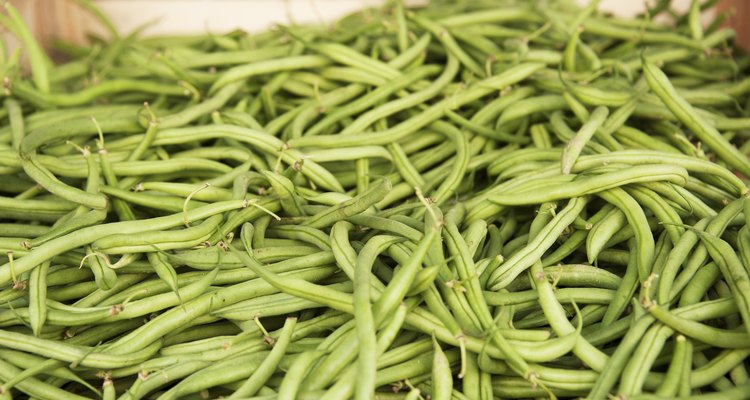
Christina-J-Hauri/iStock/Getty Images
With a crisp texture and a mildly sweet, grassy flavor, string beans, also called snap beans, make a healthful addition to your diet. According to the USDA guidelines, string beans fall into the "other vegetables" category, as opposed to beans and peas, starchy vegetables or dark green, red or orange veggies. Each cup of string beans provides one-quarter of the weekly "other vegetable" intake for women and one-fifth for men. String beans boast an impressive nutritional profile, and they offer nutrients ranging from dietary fiber to essential minerals.
Calories and Macronutrients
String beans make a great addition to a calorie-controlled diet, because each cup contains just 31 calories, or 2 percent of the daily calorie intake in a 2,000-calorie diet. Each serving of string beans offers 7 grams of carbohydrates, including 2.7 grams of dietary fiber, as well as 2 grams of protein and less than half a gram of fat. The carbohydrates in beans provide energy while their fiber content promotes digestive health, and the beans' protein content maintains the health of your hair, muscles and skin.
Vitamins A and C
Add string beans to your diet as a source of vitamins, particularly vitamins A and C. Your body uses vitamin A to support your immune system, as well as to maintain healthy skin and eyes, while vitamin C maintains the strength of your blood vessels, bones and teeth. A cup of string beans offers 12 milligrams of vitamin C and 690 international units of vitamin A. This provides 16 percent of the vitamin C and 30 percent of the vitamin A requirements for women, as well as 14 and 23 percent of the recommended daily vitamin C and A intakes for men, respectively, according to the Institute of Medicine.
String Beans Pump Up Your Iron
String beans also provide a considerable amount of iron, as well as small amounts of other minerals. Iron plays a central role in your body's ability to use oxygen -- it allows your muscles to store oxygen for future use, and helps your red blood cells circulate oxygen in your bloodstream. Each serving of string beans contains 1 milligram of iron -- 6 and 13 percent of the Institute of Medicine-recommended daily intakes for women and men, respectively. String beans also serve as modest sources of magnesium, calcium and phosphorus.
Eating More String Beans
String beans are a convenient snack served raw -- eat them on their own, or pair them with hummus, guacamole or fresh salsa. Use string beans as a healthful side dish -- they work well lightly coated in toasted sesame oil and then roasted, or sauteed with minced garlic and olive oil. Alternatively, steam string beans and season with lemon juice and black pepper. Eat the steamed beans as a side dish, and use any leftovers as a topping for leafy green salad or as a filling for wraps.
Related Articles
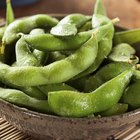
The Nutritional Value of Edamame Beans

The Nutrition of 15-Bean Soup

Nutrition Information on Blueberries

What Are the Health Benefits of ...
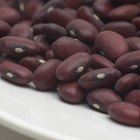
Red Kidney Beans Nutrition
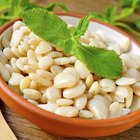
Calories per Cup of Cooked Navy Beans
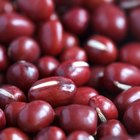
Nutrition Information for Adzuki Beans

What Is the Nutrition for Cranberry ...

Top Vegetables With Selenium

Green Bean Nutrition

List of High Protein Vegetables

Cracked Wheat Nutrition

Vitamins for Mental Alertness
Best Crock-Pot Pinto Beans Recipe

What Does Eating a Lot of Spinach Do ...

What Are the Benefits of Great Northern ...

Are Bean Sprouts Good for You?

Avocado Serving Size & Nutrition

How to Use Lettuce for Hair Growth

How to Bake Fresh String Beans in the ...
References
- University of Kentucky: Snap Beans
- USDA National Nutrient Database: Beans, Snap, Green, Raw
- Linus Pauling Institute: Iron
- Linus Pauling Institute: Vitamin C
- Linus Pauling Institute: Vitamin A
- Linus Pauling Institute: Fiber
- University of Utah Health Center: Finding the Right Mix of Carbs, Proteins, and Fats
- USDA ChooseMyPlate: How Many Vegetables Are Needed Daily or Weekly?
Writer Bio
Sylvie Tremblay holds a Master of Science in molecular and cellular biology and has years of experience as a cancer researcher and neuroscientist.
Photo Credits
Christina-J-Hauri/iStock/Getty Images